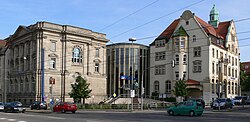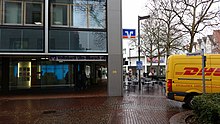Volksbank Ulm-Biberach
|
|
|
|---|---|
 Head office in Ulm at Olgaplatz |
|
| Country |
|
| Seat | 89073 Ulm |
| legal form | registered cooperative |
| Bank code | 630 901 00 |
| BIC | ULMV DE66 XXX |
| Association | Baden-Württemberg Cooperative Association |
| Website | www.volksbank-ulm-biberach.de |
| Business data 2018 | |
| Total assets | EUR 2,759 million |
| insoles | EUR 3,645 million |
| Customer credit | EUR 2,430 million |
| Employee | 526 |
| Offices | 30th |
| Members | 74,416 |
| management | |
| Board | Ralph P. Blankenberg (speaker), Stefan Hell, Alexander André Schulze |
| Supervisory board | Peter Kulitz , chairman |
| List of cooperative banks in Germany | |
The Volksbank Ulm-Biberach eG is a cooperative bank with headquarters in Ulm . It is the oldest cooperative bank in the Ulm area, represented at 30 locations in the region. With total assets of more than 2.7 billion euros (2018), it is the largest Volksbank in the Ulm-Oberschwaben area.
history
founding
The institute was founded on September 5, 1863. The reason for this was the pressing credit problem at the time. That is why the boards of the civil society and the trade association in Ulm called a citizens' meeting on May 30th. A few weeks later, at the founding meeting on August 22nd, it was decided to found the Gewerbebank zu Ulm . The new bank opened its doors on October 1st. Since the bank developed very well in the first 25 years, the central bank Württembergischer Volksbanken was founded in 1898 under the influence of the commercial bank as the first central bank in the commercial cooperative sector. The positive development continued in the following years, so that in 1905 the bank posted sales of 205 million marks. In 1905 the new building, which is still the company's headquarters today, was inaugurated and moved into.
Merger with the Ravensburg commercial bank
In 1908, the Ulm commercial bank merged with the Ravensburg commercial bank. In 1913, the Ulm commercial bank celebrated its 50th anniversary. The bank now had over 2,251 members and total assets of 17.4 million marks. This made it the largest bank in Ulm.
Second World War
During the Second World War, the Hirschstrasse branch was destroyed, as was almost the entire city center of Ulm. The head office was the only bank building in Ulm to remain intact.
Expansion of the business area
In the fifties and sixties, further branches were established inside and outside the city area. For example in 1956 in Söflingen and in the new district on Eselsberg, in January 1957 in the Blautal community of Klingenstein, in 1959 in the Ulm suburb of Wiblingen, in 1961 in Böfingen and the Dietenheim branch for customers in the Württemberg part of the Illertal. In 1959 the bank set up branches in Senden-Ay and Langenau. In 1960, the Neu-Ulm office was set up to supply members and customers in Neu-Ulm, which was later followed by branches in Offenhausen and Pfuhl. Mergers followed:
- 1959 Volksbank Illertissen
- 1971 Raiffeisenbank Ulm-Grimmelfingen
- 1972 Volksbank Quantities
- 1976 Small credit bank for Ulm and Upper Swabia
- 1986 Raiffeisenbank Illertissen
- 1987 Wiblinger Bank
- 1994 Raiffeisenbank Jungingen
- 1997 Raiffeisenbank Ulm-Süd
In 1983 Volksbank Ulm installed the first ATM in the center. In 1990, the Ulmer Volksbank was the first Ulm bank to introduce electronic cash to the Ulm retail trade. In 1993 the Junge Ulmer Volksbank was founded.
Merger with Volksbank Biberach eG
In an extraordinary meeting of representatives of the Ulmer Volksbank in November 2007, the merger with Volksbank Biberach was decided after the decision in Biberach had been the same. The effective date of the merger was January 1, 2008.
engagement
The bank has been operating the crowdfunding platform "Many create more" since 2016 . Here citizens and banks can donate to charitable projects in the region. Volksbank Ulm-Biberach has also been awarding the "Responsibility Award" every two years since 2016, honoring regional commitment in the areas of ecology, economy and ethics / social issues. In 2018, projects were funded through donations and sponsorship totaling 640,000 euros.
Web links
- Volksbank Ulm-Biberach in the company database of BaFin
- Official website
- Crowdfunding platform from Volksbank Ulm-Biberach eG
Individual evidence
- ↑ a b Master data of the credit institute at the Deutsche Bundesbank
- ↑ Annual report 2017
- ↑ Imprint of the bank
Coordinates: 48 ° 24 ′ 7.8 " N , 9 ° 59 ′ 50.1" E
